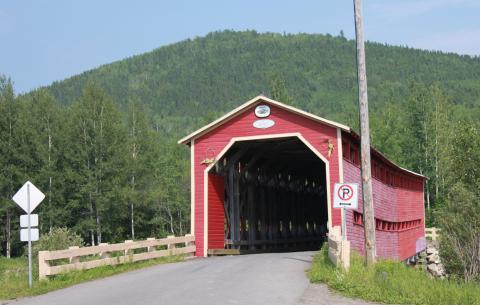
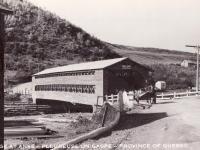 At one time, there were covered bridges all over the Gaspé peninsula. Today, only a few of these historic spans remain. Most have fallen victim to demolition in the name of progress, vandalism or the elements, some within the last few years. A handful remain, however, notably the splendid example in Grande-Vallée (the only surviving covered bridge on the north Gaspé coast), the long bridge in Saint-Edgar (near New Richmond), and three in the area around Rimouski and Mont-Joli. But the greatest concentration may be found along the Matane and Matapedia River valleys.
At one time, there were covered bridges all over the Gaspé peninsula. Today, only a few of these historic spans remain. Most have fallen victim to demolition in the name of progress, vandalism or the elements, some within the last few years. A handful remain, however, notably the splendid example in Grande-Vallée (the only surviving covered bridge on the north Gaspé coast), the long bridge in Saint-Edgar (near New Richmond), and three in the area around Rimouski and Mont-Joli. But the greatest concentration may be found along the Matane and Matapedia River valleys.
Most people who have crossed the Gaspé peninsula by car from Matane to Matapedia (or at least those who have done so during the day) will have noticed that the route is punctuated by covered bridges. The drive follows Route 195 along the placid Matane River Valley, then crosses over the Gaspé highlands, until the highway meets Route 132 at Amqui. At Amqui, the 132 continues south along the scenic Matapedia River.
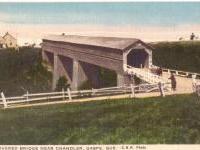 The views along this entire drive are lovely. At times they are breathtaking. A highlight of the trip, which can easily be done in about three hours, is the rugged scenery along the fast-flowing Matapedia, which is lined on each side with steep cliffs. The Matapedia, of course, is famous as a spawning ground for salmon.
The views along this entire drive are lovely. At times they are breathtaking. A highlight of the trip, which can easily be done in about three hours, is the rugged scenery along the fast-flowing Matapedia, which is lined on each side with steep cliffs. The Matapedia, of course, is famous as a spawning ground for salmon.
Another highlight of the drive are the covered bridges that one can hardly fail to spot along the way. These bridges have been points of interest since tourists first starting coming to this area in the early 1900s. American travelers, believing that covered bridges were native only to New England, would write home expressing their surprise at discovering them in such abundance in the Gaspé. Many postcards from the period depict the covered bridges of the Gaspé coast.
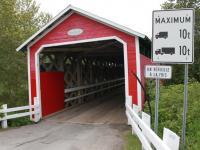 Beginning on the north side of the Gaspé coast, the first covered bridge on the Matane-Matapedia route is located in Saint-Ulric-de-Matane, a few kilometres west of Matane on Route 132. This bridge, the Pierre-Carrier Bridge, is located on chemin du Pont-Couvert, just south of the village.
Beginning on the north side of the Gaspé coast, the first covered bridge on the Matane-Matapedia route is located in Saint-Ulric-de-Matane, a few kilometres west of Matane on Route 132. This bridge, the Pierre-Carrier Bridge, is located on chemin du Pont-Couvert, just south of the village.
As they do near most covered bridges in Quebec now, signs indicate the direction of the bridge from the main highway. The bridge is located at the bottom of a little valley, within sight of a sprawling wind farm.
 The bridge itself, which measures only 25 metres, was built in 1918, making it one of the oldest surviving covered bridges in the region. It was named after the man on whose land it was constructed by Quebec's Ministry of Colonization. The Ministry of Colonization was the department responsible for building many of the roads and bridges in this and other parts of the province.
The bridge itself, which measures only 25 metres, was built in 1918, making it one of the oldest surviving covered bridges in the region. It was named after the man on whose land it was constructed by Quebec's Ministry of Colonization. The Ministry of Colonization was the department responsible for building many of the roads and bridges in this and other parts of the province.
In 2000, the Pierre-Carrier Bridge was restored by the municipality which, as a result, received a prize from the Conseil de la culture du Bas-Saint-Laurent.
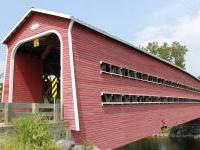 Continuing through Matane, travelers will take Route 195 south from that town. Here the road winds its way along the gentle valley of the Matane River. At one time, there was a covered bridge every few kilometres. A few still survive. South of Matane, the first bridge is the Jean-Chassé Bridge, a beautiful specimen a few kilometres north of Saint-René-de-Matane.
Continuing through Matane, travelers will take Route 195 south from that town. Here the road winds its way along the gentle valley of the Matane River. At one time, there was a covered bridge every few kilometres. A few still survive. South of Matane, the first bridge is the Jean-Chassé Bridge, a beautiful specimen a few kilometres north of Saint-René-de-Matane.
Built in 1945, the Jean-Chassé Bridge is impossible to miss. Like the Pierre-Carrier Bridge, it is painted bright red. This bridge, however, measures over 44 metres from end to end. It spans the Matane River just off the highway, on de la Montagne Road.
 Like most Colonization bridges, the Jean-Chassé Bridge was designed with a structure known as the Town lattice. This was the "official" design for government-sponsored covered bridges throughout the province.
Like most Colonization bridges, the Jean-Chassé Bridge was designed with a structure known as the Town lattice. This was the "official" design for government-sponsored covered bridges throughout the province.
A covered bridge's truss, or superstructure, was meant to support the bridge's weight as well as its load. The roof was simply a way of protecting the truss from the elements. The Town truss was considered an especially strong one. And, as it required a great deal of timber, it was an appropriate design for Quebec's timber-producing regions.